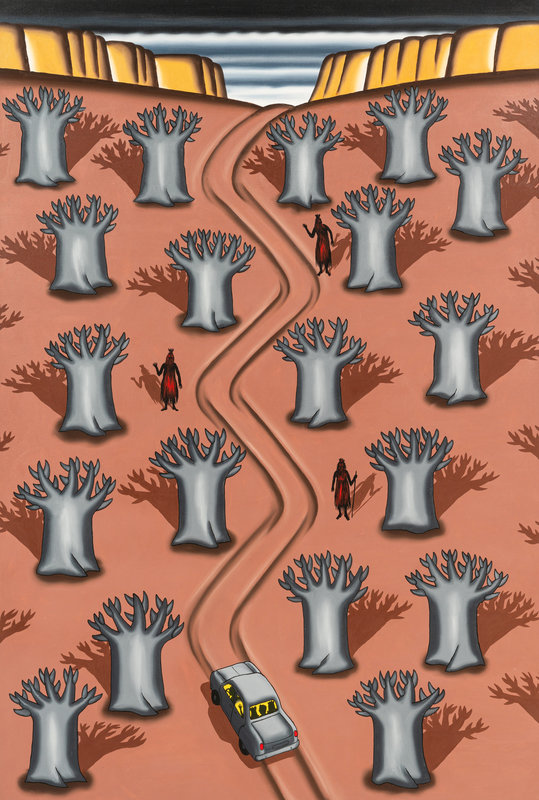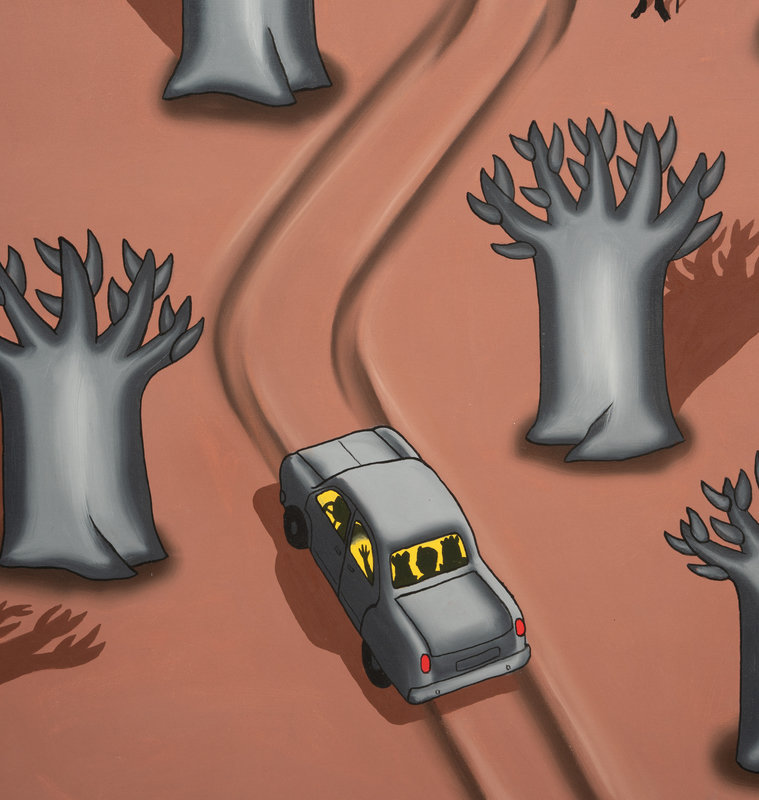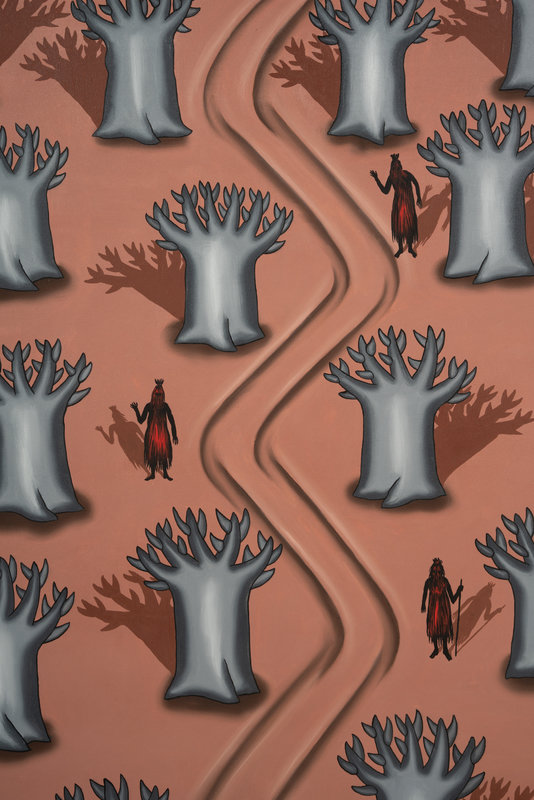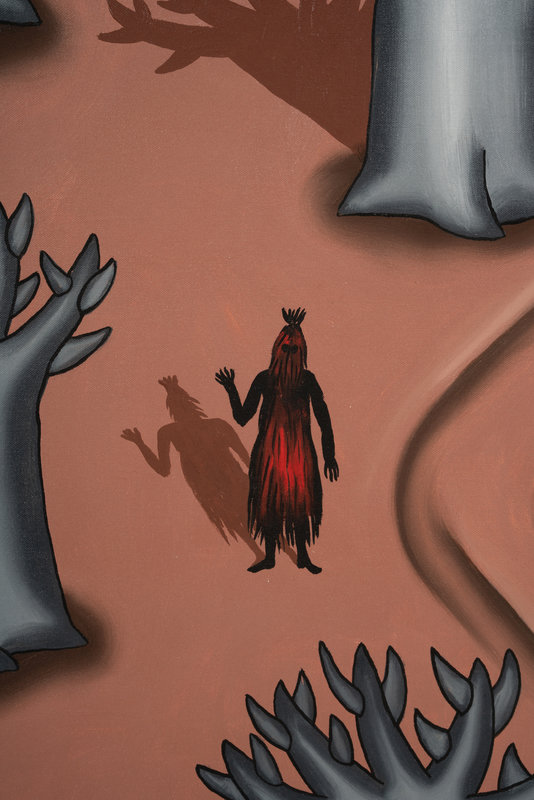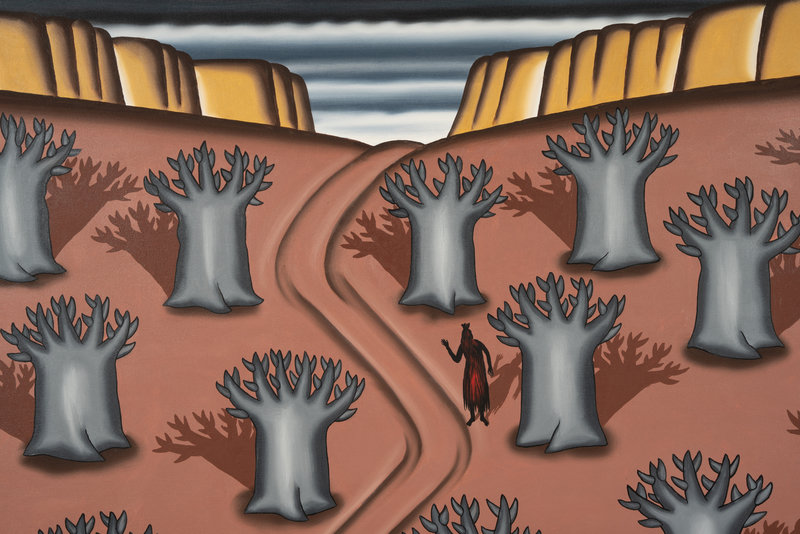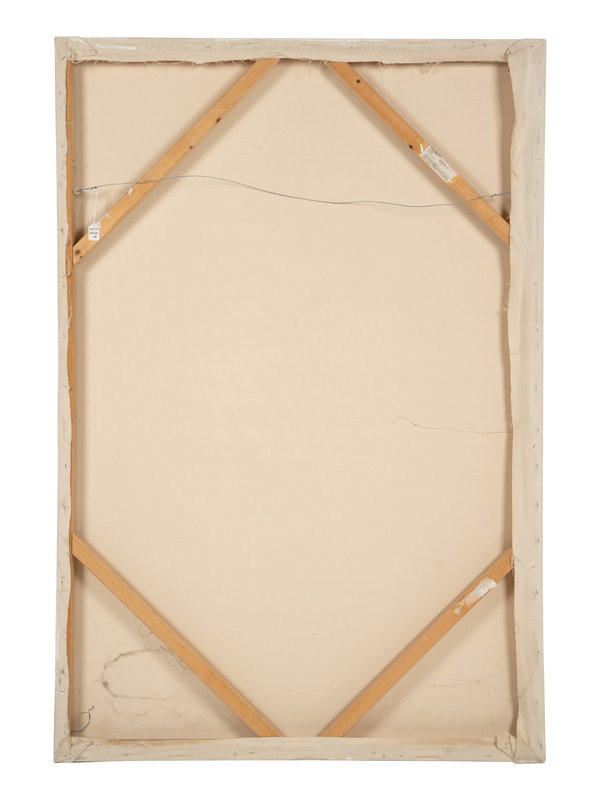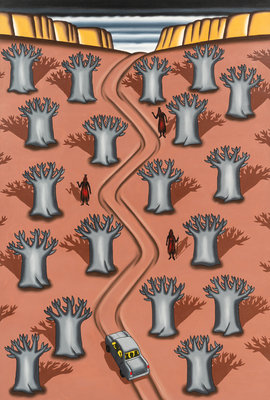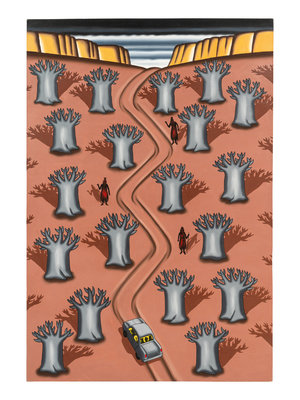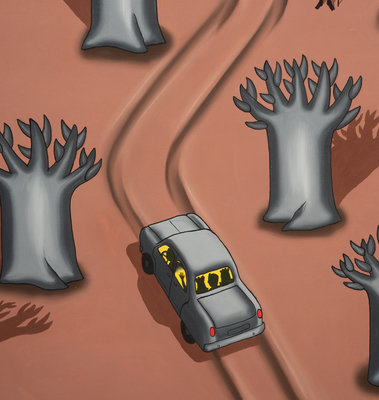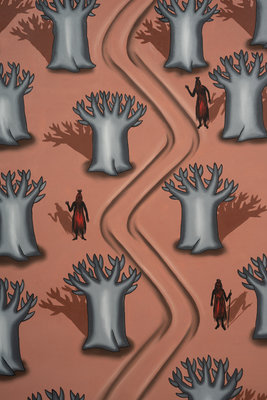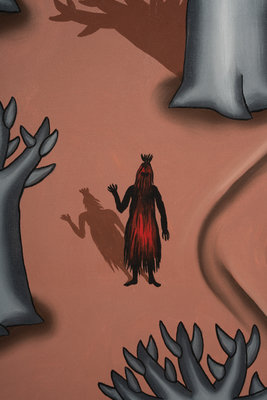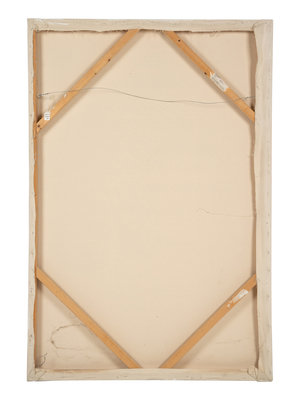Provenance:
Helander Gallery, Palm Beach
Phyllis Kind Gallery, Chicago
Lot Essay:
Roger Brown and Susann Craig’s 1988 trip to West Africa
Roger Brown made a number of stellar paintings in 1989. It was a prolific year full of responses to all manner of subjects and issues. He made studies for his first two major public murals created in Italy in glass mosaic, The Arts and Sciences of the Ancient World: The Flight of Icarus and Daedalus and Arts and Science of the Modern World: LaSalle Corridor with Holding Pattern, both unveiled, outside and inside respectively, at 120 N. LaSalle St. in July 1991. That year he also painted Chicago Taking A Beating featuring the skyscrapers of his home city––-the truly windy city––buffeted by swirling gusts. He parodied his distant cousin, Elvis Presley, and made a profoundly thoughtful, enigmatic homage to Abraham Lincoln. That year he also painted African Hotel and Crossing the Bandiagara Escarpment With Baobab Trees and Dogon Dancers. Both entered Phyllis Kind Gallery in spring 1989.
Brown chose two episodes to commemorate the 1988 trip with Susann Craig and a band of roving collectors through Senegal and Mali. Upon returning he recounted their trip, day by day, in longhand on 22 pages of a yellow legal pad. Following are excerpts (transcribed with minimal corrections):
My friend Don Baum told me about a tour to Dogon Country in Mali, West Africa. The tour was being co-organized by Susann Craig who I have known for many years as a fellow enthusiast of Folk arts, so I felt this would be an ideal way to see the country which has fascinated me through photographs and through the Dogon artifacts I have collected. So I signed up.
This trip would be to Senegal and Mali and would include more than Dogon country. Susann Craig’s partner was Lowell Nelson a designer of exotic skin handbags. Two of his employees, natives of Senegal named Modi and Tgor/Tjon would help us along.
A few days before leaving Chicago I met Lowell Nelson, described by the N.Y. Times as a Conradian figure.* He stopped by my studio to pick up color portraits for my visas. My impression of him was something of a cross between Burl Ives + Grizzly Adams. He seemed capable of negotiating a crime with Humphrey Bogart aboard the African Queen.
March 9th we arrived at Dakar around 10 a.m.
Brown described the first destination on the journey as a sober experience that didn’t involve markets, collecting, or exotic landscapes:
March 10 We took the ferry to the Island of Goree where the slaves were shipped out in the 18th + early 19th centuries. The island is just as it was then - with colonial stucco buildings in muted pinks + ochres. The original building stands at the edge of the water where the victims of slave trade were kept.
Brown went on to describe their visits to various markets, strategies for outsmarting pickpockets, and various delectable meals, from Senegalese to Vietnamese fare. Lowell finds good places to eat.
March 11th This morning we left for Rose Lake a salt water lake which is red from algae where the swimmers, as Susann says, float like a cork. On the way we photographed The Baobab trees, huge elephant-like trees that we are told is the nesting place of the Senegal eagle and can reach 25 meters around. We stopped briefly at a loud village market which is somewhat akin to our own Chicago’s Maxwell Street.
Mar 15th On the way to the Dogon region we traveled a dusty red clay + dirt road for about forty miles to Bandigiara [sic]. The landscape becomes very much like the southwest with mesa like forms in the distance + the red earth changing to bedrock looking much like the Great Plains if they were solid rock. Intermittently pockets of earth + trees appear among the boulders. From Bourdigara [sic] the road becomes a red clay and bedrock trail for 40 more miles across gulleys paved so they won’t wash away in the rainy season. More and more villages dot the landscape with their square mud brick + thatched roof granarys for each house.
On the way out of this central area of the Dogon region we passed some men in costume. We learned that they were dressed that way as part of a continuing ritual for their recently deceased leader.
Anyway we all pigged out at the market: some with necklaces + bracelets and me + Susann with masks + granary door latches, weavings and kaftans.
Ever the critic, Brown apparently enjoyed the trip immensely. It’s interesting his notes include no complaints, unlike his notes from other journeys, no doubt due to Susann Craig’s perennially upbeat, adventurous spirit, her infectious sense of humor, and the high-keyed delight in art and objects they both shared.
I also thought that so far this is an exceptional tour. It’s really a nice group of people and the group is small.
There’s none of the squeamishness you’d expect from American travelers. They all have a real interest in the culture + art and the people. They aren’t just “slumming” or gawking and most of all Lowell has done an outstanding job organizing the tour and using his knowledge so that we can have this truly rare + wonderful experience.
In 1989 Susann saw Brown’s painting Crossing the Bandiagara Escarpment With Baobab Trees and Dogon Dancers at her friend Phyllis Kind’s Gallery (Chicago), and immediately knew she had to have it. She related stories over the years of haggling with Phyllis, a savvy gallerist renowned for driving hard bargains. Craig was a savvy collector, also known for her skill and pluck with dealers. I recall that negotiations were at a standstill for some time, perhaps a few years, when Susann finally prevailed and acquired the painting she was destined to have, install and live with in her incomparable art-filled home. It was the backdrop for regaling friends with tales of their intrepid journey for many years.
From Brown’s trip notes we can surmise that his composition combined a few commanding images and experiences from the trip: the Baobab trees they marveled at in Senegal on March 11 (and perhaps elsewhere on the journey), and their encounter with Dogon people in Mali, dancing in full ritual regalia. On a visit to her loft in 2017 Susann brought out images of the Baobab trees and the Bandiagara dancers, which she kept nearby, to illustrate moments Brown chose to depict in his painting. Susann described their chance coming upon the dancers many times, as one of their encounters with authentic life practices, not created for or directed to tourists. If only I had taken notes—but who took notes at Susann Craig’s?!
As Dennis Adrian used to remark when a remarkable Chicagoan passed, “a giant redwood fell in the forest.” Giant redwoods fell when we lost Roger Brown (1997) and Susann Craig (2021). They both enriched many lives, and the art culture of the city, immeasurably.
Lisa Stone
January 2023
*Presumably a reference to Joseph Conrad, author of Heart of Darkness.
Credit line:
Roger Brown (1941-1997), Crossing the Bandiagara Escarpment With Baobab Trees and Dogon Dancers, 1989, oil on canvas, 78 x 42 in. © The School of the Art Institute of Chicago and the Brown family.
